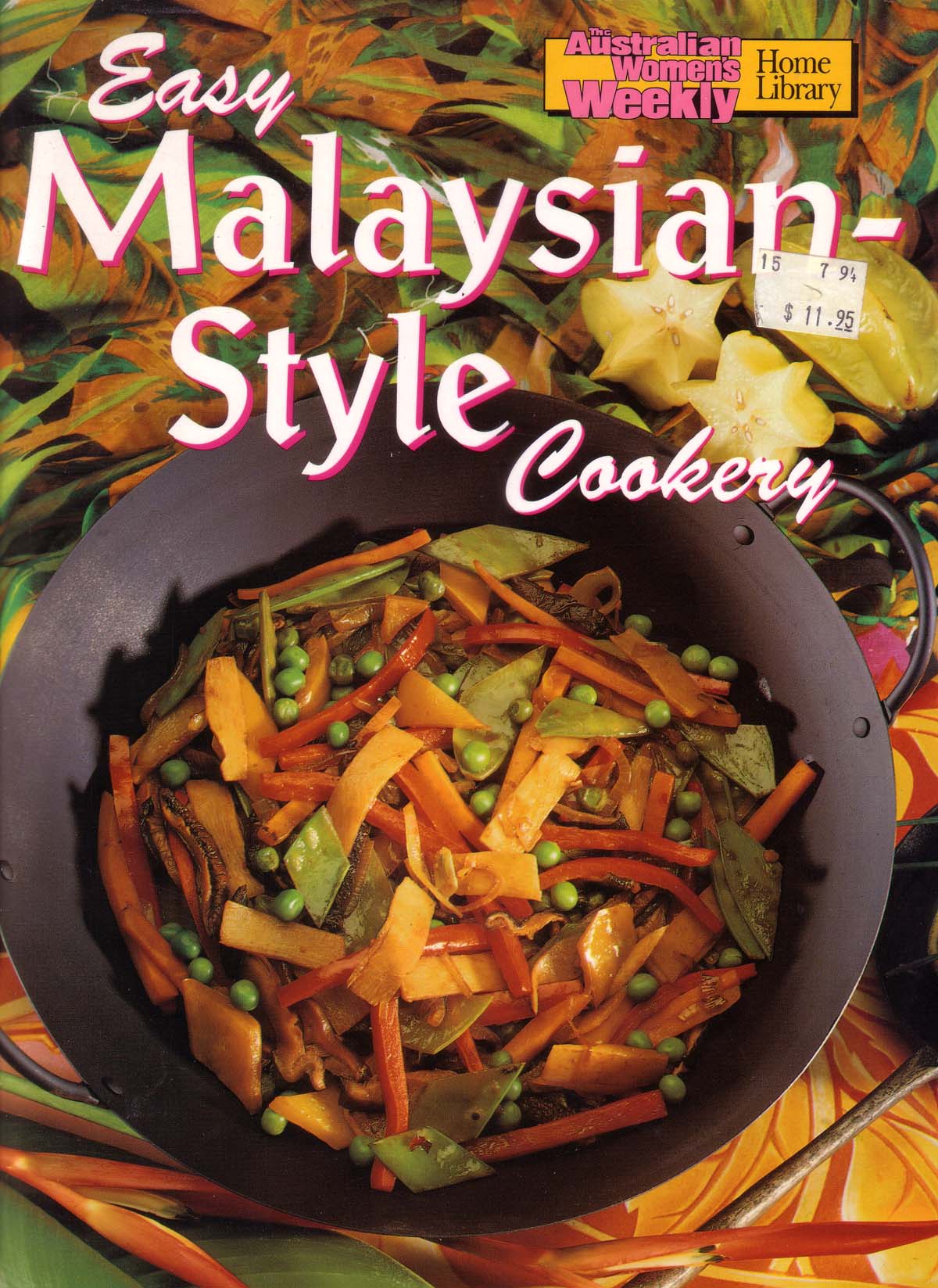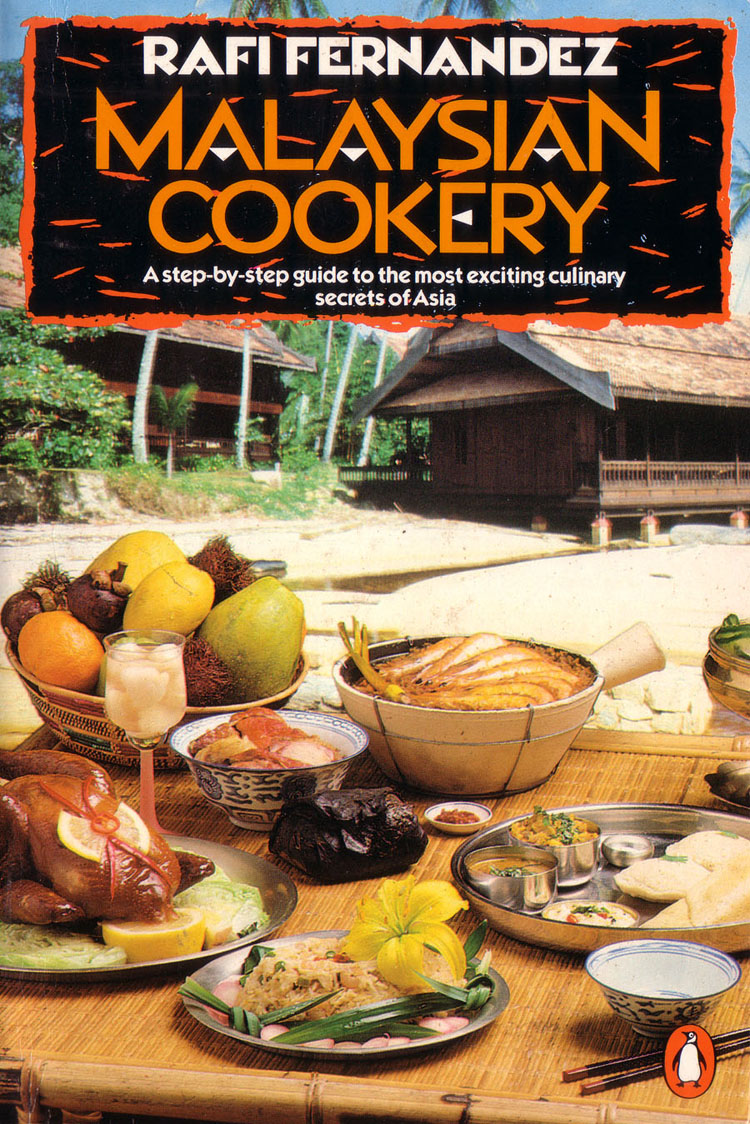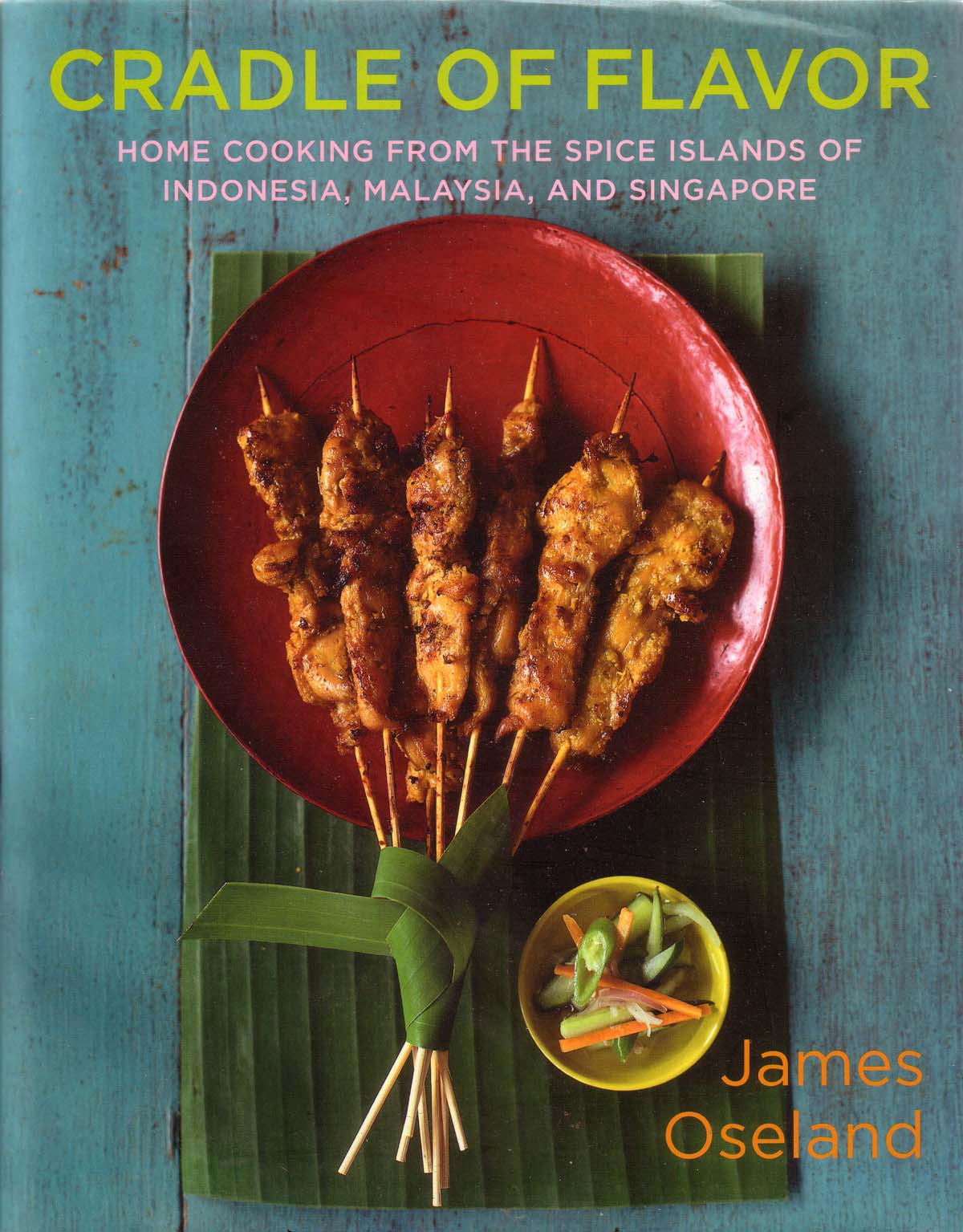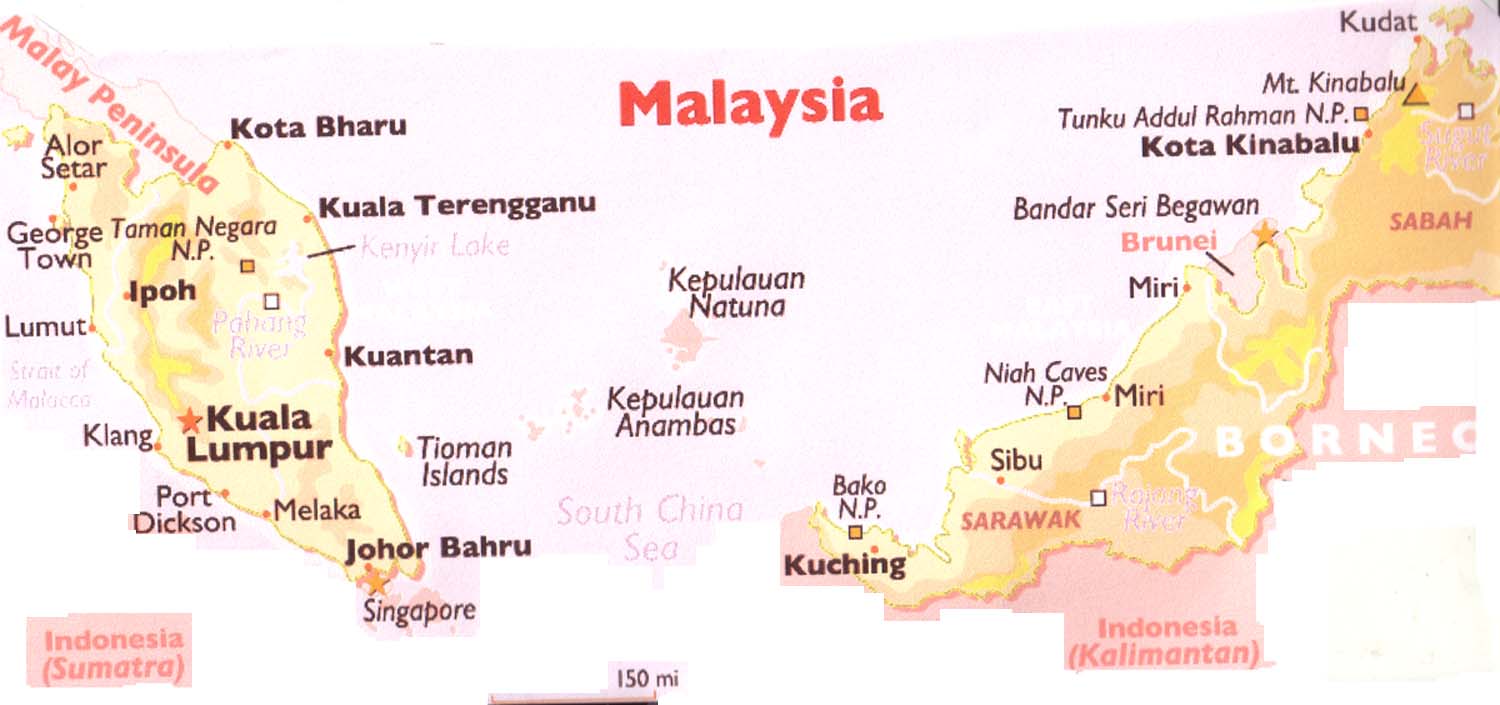
| What is Flavor and Fortune? |
| How do I subscribe? |
| How do I get past issues? |
| How do I advertise? |
| How do I contact the editor? |
Read 7002614 times
Connect me to:
| Home |
| Articles |
| Book reviews |
| Letters to the Editor |
| Newmans News and Notes |
| Recipes |
| Restaurant reviews |
| Article Index (all years, slow) |
| List of Article Years |
| Article Index (2024) |
| Article Index (last 2 years) |
| Things others say |
| Related Links |
| Log In... |
| Authors |
| Categories & Topics |
Malaysian-Chinese foods
| by Jacqueline M. Newman |
Chinese Food in Asia (but not China, Hong Kong, or Taiwan)
Spring Volume: 2013 Issue: 20(1) page(s): 11 - 14, and 34
 Chinese people from the Malay Peninsula, now called The Federation of Malaysia, live in a country divided into two regions, West Malaysia, which is also known as Peninsula Malaysia, and East Malaysia, which is primarily Sabah and Sarawak. Not close at all, Beijing to Kuala Lumpur--on the west side of the Malay Peninsula, is two thousand seven hundred miles south and a mite west. The main peninsula is south of Thailand and just north of the equator, and as the map shows, it has many islands; and some say, the most beautiful beaches on the planet.
Chinese people from the Malay Peninsula, now called The Federation of Malaysia, live in a country divided into two regions, West Malaysia, which is also known as Peninsula Malaysia, and East Malaysia, which is primarily Sabah and Sarawak. Not close at all, Beijing to Kuala Lumpur--on the west side of the Malay Peninsula, is two thousand seven hundred miles south and a mite west. The main peninsula is south of Thailand and just north of the equator, and as the map shows, it has many islands; and some say, the most beautiful beaches on the planet.
The region's archeologic and other evidence showing humans here more than forty thousand years ago, many kingdoms ruling, and in 1511, Portugal conquering the Sultanate of Malacca. Thus, it was the first European power to have access to the Southeast Asian trade route. The Netherlands and Spain took over from them, and the Dutch took over from them. Then, the British recognizing the strategic importance of the region and the country colonized and controlled the region circa the 1800s.
The current country of Malaysia is surrounded on three sides by the sea, and it enjoys a mild and humid climate. Folks from here tell us they are blessed with light rain almost every day. Thus their flora and fauna are many, and the country produces lots of delicious fruits and vegetables, lots of rice–-their staple grain, and they enjoy plenty of seafood.
 The Chinese first came to Malacca as traders. The men settled down, as did those coming to Singapore, and they married local women. Most came in the 1840's or soon thereafter, lesser numbers later than that. Some adopted Christianity, most remained Buddhists.
The Chinese first came to Malacca as traders. The men settled down, as did those coming to Singapore, and they married local women. Most came in the 1840's or soon thereafter, lesser numbers later than that. Some adopted Christianity, most remained Buddhists.
Since then, three large ethnic groups make up the local population. They are the Chinese, the Indians, and of course the Malays. The term Malay here is the ethnic name of the Muslims who make up more than half of the population of the country. Besides these three groups, there are lesser numbers of Orang Ashi, Senoi, Temiar, Europeans, and Eurasians.
This multi-ethnic population includes seven million Chinese, Indian, Celonese, Eurasian, Portuguese, Aborigines, and the Malays who live together in fourteen states ruled by a Sultan. Every five years the resident population elects one of their own to be the King of all of Malaysia.
 This multi-ethnic, multi-cultural, and multi-linguistic society does have a national religion, it is Islam. In the fifteenth century, they inherited it from India. The tale told of why Islam, is that a Hindu prince there converted to Islam, took up the title of 'Sultan Muzaffar Shah,' and ruled this country.
This multi-ethnic, multi-cultural, and multi-linguistic society does have a national religion, it is Islam. In the fifteenth century, they inherited it from India. The tale told of why Islam, is that a Hindu prince there converted to Islam, took up the title of 'Sultan Muzaffar Shah,' and ruled this country.
Before his arrival and that of the many newer immigrants, the long-time local residents included Birgis, Minangakabau, Javanese, other Indonesians, and folk from the British colonies nearby. The Indian people in this country are not a single population; they include Tamils. Sikhs, and Hindus. The Chinese, also not one group, speak more than seven language groups, most are from China's southern mainland; and they speak Cantonese, Mandarin, Fujianese, Hokkein, Hakka, and Hainanese. Where they came from and who they are is also a mixed group.
Thousands of Chinese came first to Singapore, and when tin was discovered in the Malay Peninsula many of them moved to Penang, Malacca, Kuala Lumpur, and Taiping in Malaysia. Some came to work in the gold mines and the coal fields of Sarawak or to what was then North Borneo and is now Sabah. Others came later to the rubber plantations.
 These varied populations brought not only their languages but also their holidays and their home-country cooking. They quickly adopted a love for local spices, particularly the chilies found here, and the local fruits. They adopted a love for local soups such as Laksa, Indian breads including roti, Malay-style fish or chicken curry dishes, and the creamy texture of kway teow, the local rice-flour noodles fried with shrimp, bean sprouts, and eggs. They have since made them their own and added them to dishes brought from home.
These varied populations brought not only their languages but also their holidays and their home-country cooking. They quickly adopted a love for local spices, particularly the chilies found here, and the local fruits. They adopted a love for local soups such as Laksa, Indian breads including roti, Malay-style fish or chicken curry dishes, and the creamy texture of kway teow, the local rice-flour noodles fried with shrimp, bean sprouts, and eggs. They have since made them their own and added them to dishes brought from home.
Meals in Malaysia include these dishes and are commonly placed on the table under nets, family members and guests helping themselves when hungry. Most food is served at room temperature or cold, and lunch and dinner are generally similar with dinner often adding a vegetable or an egg dish besides the type of foods served earlier in the day. The Chinese in this country eat these dishes together and with chopsticks. Not all Malay come to the table at the same time.
In Malaysia today, some twenty percent of the population are Buddhists, three percent believers in Confucianism and Taoism, and more than sixty percent practicing Muslims. They speak their own languages, though the country does have an official language, Bahasa Malaysia. Like their multi-cultural foods, many languages are spoken here, their people influenced by everyone's languages, foods, and holidays. The greatest influences here are from India, China, Indonesia, and Sri Lanka. People speak some one hundred and forty different tongues, many use English, and they celebrate each other's holidays second to their own.
For the Chinese, New Year is still the most important holiday, they keep the reunion dinner and the entire family gets together on New Year's eve. They each use a flat plate, a rice bowl, a sauce dish, tea cup, and chopsticks.
Chinese breakfast in Malaysia can include noodles in soup, rice porridge or dumplings or both, and all made with local tastes. Lunch can be a single soup or a single dish if no guests are visiting, or more like dinner if others are at their tables. These main meals can include a fish dish or two, a vegetable dish, rice and/or noodles, and a soup, and perhaps even an egg dish. They will taste from added Indian spices, include more soy sauce than they would have in China, and it will be both superior soy which is their thin soy, lots of dark or thick soy, and some will include a fish sauce.
In spite of the cultural and language mix, foods do not totally get mixed, though meals do. There is some mixing in produce and spices, the addition of belacan, tamarind, local vegetables, assorted rices and grains, meats, and seafood, and the addition of coconut milk to give them local flavor. While there are these mixtures at the table, the groups do not mingle much outside of work and school, and rarely do they intermarry; though that is beginning to change.
The Chinese were originally thought to be sojourners not planning to stay over the long-term. However, after 1920, their population substantially increased after World War II, and now it seems they plan to stay and keep the Malay-born Chinese company for the long-term. This might be because they became very rich, and did like being local capitalists and an urban proletariat. Hence, they demanded citizenship and a role in the political process of this new democratic nation, have less desire to return to China since Mao took over, even less after the Communists had a firm hold on China's government. That said, they now seem settled in for the long haul.
The three main ethnic populations do interact in public places, certainly not in things religious as the Malays are mostly Muslim, the Chinese mostly Buddhists and there are a few Christians. They find many Malay beliefs strange and feel the same the same about the Muslims from India. Intermarriage does require an irreversible shift to customs of the other partner including food, holidays, and other daily life behaviors. This is slow to happen, but some can and does.
The Malay practice their Islamic faith, and most do not eat pork, do not drink alcohol, and never consume animals not ritually slaughtered according to their halal beliefs. Besides inter-religious and inter-dietary dining differences, intermarriage means living in a Malay-acceptable home where praying five times a day is a common practice as is celebrating Ramadan and other Islamic holidays, eating halal or ritually acceptable foods, and practicing other beliefs the Chinese are not familiar with.
For them, it can mean giving up their New Year holiday, firecrackers, burning of fake money, removing ancestor memorials from their homes, ceasing the practice of Buddhism, etc. The Indians who are not Muslim, also need to change their lives and demarcate themselves from the majority. Those living outside of Malaysia's big cities can find themselves socially segregated, as many Chinese already are from their Malay neighbors.
On the economic front, the Chinese have more income, live clustered in commercial areas, and are over-represented in fields that require higher education. Indians in Malaysia are closer to the Chinese then to the Malay people in many of their life-styles. To put this in numerical perspective, this country of some thirty million people live on somewhat more than one hundred twenty-five thousand square miles and are about fifty percent Malay, thirty-seven percent Chinese, and eleven percent ethnic Indian. The capital is Kuala Lumpur, the seat of government is Putrajaya. The original Malay Kingdoms started to became the Federation of Malaysia in 1948, gained independence in 1957, were united with Sabah and Sarawak, then East Malaysia, and with Singapore in 1963. Then their government did expel Singapore from the federation, and they now refer to their government as a Federal Constitutional Monarchy, their land as Peninsula Malaysia and Malaysian Borneo.
This multi-cultural country is mostly jungle. It boasts more than two thousand different kinds of trees, two hundred types of mammals, four hundred and fifty bird species, one hundred fifty thousand varieties of insects, and hundreds of edible fruits and vegetables, these numbers not known.
Overall, the country have goals, called Vision 2020. These are to raise its industrialization, take greater advantage of their rubber trees, oil fields, mining sector, and their many spices, also their palm oil and other agricultural economics.
In this federation of many ethnic populations holidays are divided, too. They celebrate Hari Merdeka or Independence Day on August 31st; also Labor Day in May, and the King's Birthday the very first week of June; all others are intra-ethnic.
While food is a mixed bag, most Malaysians love Laksa, Chicken Rice with origins from the Chinese of Hainan Island with a Malaysian twist, and other mixed or multi-ethnic dishes. The Chinese adore the local Satays or skewered meats probably from Arab merchants who plied the area early in the 15th century, and they love their own Chinese dishes.
Other culinary influences are those of the Portuguese who occupied Malacca for most of the 16th and 17th centuries, foods the Dutch and the British East India Company brought when they acquired Penang and Malacca and held it until the mid-1800's. Many of the foods from these groups include their beloved dried shrimp paste called belacan, also spelled blacan or blachen, palm sugar, fresh turmeric, tamarind, candlenuts, and a fermented yellow soybean paste called taucheo.
A few favorite Malaysian-Chinese recipes follow. Enjoy them all, and find others such as Nasi Kemuli which is a spicy Nonya rice, or Mee Goreng, which is their fried noodles. Keep in mind that what really defines Malaysian cuisine are Indian spices made with Chinese methods of food preparation, the use of claypots, spicy noodle dishes, and the use of the wok. These Chinese influences are credited to the women in their kitchens making their husband's home-flavored meals, using items such as local spices and coconut milk, and serving a snack called ais kacang to keep them happy. This is a shaved ice treat that sits atop sweet adzuki beans, colored cubes of gelatin, sago pearls, sweet corn, and crushed peanuts, all topped with condensed milk and one or more syrups.
For those that want to learn more about this country and cuisine, there are few books, but most are out of print, and fewer articles about the cuisine and the people's eating habits. Our bookshelves have: The Food of Malaysia, a Periplus book distributed by The Crossing Press and published by Periplus (Singapore) with a 1995 ©, its ISBN is 0-89594-770-6; Rafi Hernandez' Malaysian Cookery, a Penguin Book published in London with a 1985 ©, its ISBN is 0-14-046648-7; Easy Malaysian Style Cookery edited by Pamela Clark and published in Australia with a © of 1994, its ISBN is 1-86396-019-8; and Cradle of Flavor by James Oseland published by WW Norton & Company in New York NY, its © is 2006 and its ISBN is 978-0-393-05477-4. This last volume is about Indonesia, Malaysia, and Singapore.
Try the recipes below, in those books, or any other Malaysian ones you can locate. Taste their foods, enjoy their multi-cultural impacts, and keep in mind that their foods and those from Singapore share many of the same influences and tastes.(
| Laksa with Chinese Influences |
|---|
1/2 pound thin rice noodles, soaked until hot water until soft, then put in ice cold water 6 ounces shrimp, peeled, their veins removed, shells reserved, shrimp cut into half-inch pieces 3 Tablespoons vegetable oil 1/2 cup thick coconut milk 3 fried doufu cakes, cut in quarters 2 fish cakes, cut into small cubes 3 scallions, coarsely chopped 2 stalks lemon grass, white parts only 1 knob fresh ginger, peeled and cut into pieces 10 peeled almonds or candlenuts 1 Tablespoon belachan 5 dried chili peppers, seeds discarded 1/2 teaspoon ground turmeric 1 onion, chopped 1/2 pound bean sprouts, heads and tails removed, heads reserved, tails discarded 1/2 cucumber, peeled and cut into matchstick-size pieces Preparation: 1. Mix rice noodles, shrimp, shrimp shells in a net bag for easy removal, vegetable oil, coconut milk, three cups of boiling water, doufu and fish cake pieces in a large pot, and set aside for ten minutes. 2. Put scallions and lemon grass pieces, the ginger, almonds, belachan, chili peppers, turmeric, and the onion in a blender and make a paste turning the motor on and off. 3. Add the blended paste to the rice noodle mixture and bring to just below the boil, stir well and sinner for two minutes, not longer, then discard the shrimp shell bag before adding the bean sprout heads, the bean sprouts, and the cucumber pieces. Then serve. |
| Rojak |
|---|
1/2 pound spinach, blanched for one minute, then cooled quickly in ice water, and drained well 1/2 pound bean sprouts, heads and tails removed 1/2 pound canned pineapple, thinly sliced 1 green papaya, peeled and thinly sliced 1/2 pound doufu, sliced and deep-fried 1 cucumber, partially peeked and cubed 1/2 cup roasted peanuts, paper shells removed and discarded, then deep fried until light tan, and drained 1 Tablespoon sesame seeds 2 ounces tamarind, soaked in hot water, squeezed, and only the juice retained 1 teaspoon dried hot pepper pieces 3 Tablespoons granulated sugar 1 Tablespoon brown sugar Preparation: 1. Put all the solid ingredients in a large bowl and toss well. 2. Put the tamarind water, the dried pepper pieces, and the two sugars together and mix until the sugars are dissolved, then toss this with the vegetables and fruits. Chill, then serve. |
| Chicken Rice |
|---|
1 whole chicken or four thigh quarters salt and pepper, to taste 2 cups long-grain rice, rinsed well 2 Tablespoons vegetable oil 2 cloves garlic, peeled and minced 4 slices fresh ginger, peeled and finely minced 1 Tablespoon thick soy jam 1 Tablespoon plum sauce 1 teaspoon honey 1 teaspoon sugar, optional 1/4 teaspoon ground cinnamon 1/8 teaspoon ground cloves 1 large onion, thinly slices 1 scallion, minced Preparation: 1. Dry the chicken with paper towels, then rub the skin-side and the inside with salt and pepper. Put it in a steamer basket over a bowl or onto a steamer rack, also over a bowl. Steam for twenty minutes, then remove and set aside keeping it warm in a heat-proof bowl. 2. Use the liquid in the bowl and add water making three cups, and bring this to the boil. Add the rice, reduce the heat, and simmer until it rice is soft, fluffy, and fully cooked. 3. Heat oil in a wok or fry pan, and stir-fry the garlic and ginger for one minute. 4. Mix the soy jam, plum sauce, honey, sugar, cinnamon, and cloves, and add it to the garlic and ginger. Add in the rice. 5. Put the chicken on this, and steam another five minutes; then serve. |
| Beef On A Srick |
|---|
1 pound sirloin of beef, cut into two-inch squares 1 each, orange, red, and green peppers, each seeded and cut into one-two inch squares 1 onion, cut as are the peppers 6 skewers 1 Tablespoon vegetable oil 1 teaspoon ground cumin salt and pepper, to taste 1-inch piece of galangal, peeled and minced 1-inch piece of fresh ginger, peeled and minced 2 shallots, peeled and minced 10 stems and leaves fresh cilantro, minced 1 teaspoon ground cumin 1/4 cup thick coconut milk (not coconut water) Preparation: 1. Skewer the beef, peppers, and onion. 2. Mix the oil with half the ground cumin, and brush on the meat skewers, then grill for five minutes, rotating the skewers, as needed. 3. Make the sauce by putting all the remaining ingredients except, the last tablespoon of oil, into a food processor or a blender. Add two tablespoons of hot water, then turn the blender or food processor on and off until it makes a paste. 4. Put that last tablespoon of oil in a small pan, add the paste and stir in the blended paste and simmer until it is hot. it. Use this to brush on the skewers, then serve. |
| Duck, Straits Style |
|---|
1/4 cup vegetable oil 1 five pound duck, cut in half or in up to eight pieces 1 two-inch cinnamon stick 2 star anise 4 whole cloves 2 teaspoons five-spice powder 2 Tablespoons dark brown sugar 1 Tablespoon ground coriander 1 cup canned water chestnuts 3 Tablespoons soy jam salt and pepper, to taste 2 cloves garlic peeled and crushed 1 scallion, chopped 1 chili pepper, seeded and minced Preparation: 1. Heat oil in a wok or a deep pan, and brown the duck on all sides. 2. Put duck, all the seasonings/spices/ingredients, cinnamon through the garlic, into a deep pot. Add three cups of boiled water, stir well. Cover and reduce the heat to a simmer, and cook for half an hour. 3. Remove the duck, cut it into small pieces, and put them on a pre-heated serving plate, and cover them. 4. Reduce the liquid in the wok or pot to half a cup; it should be thickened, then pour it over the duck. Sprinkle the scallions and the chili pepper pieces over it, and serve. |

Copyright © 1994-2024 by ISACC, all rights reserved
Address
3 Jefferson Ferry Drive
S. Setauket NY 11720